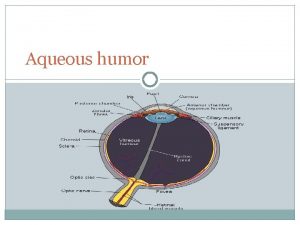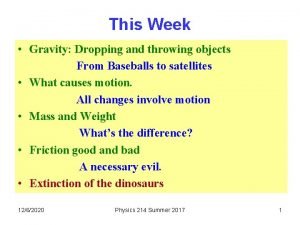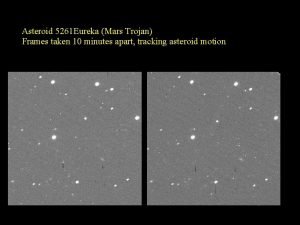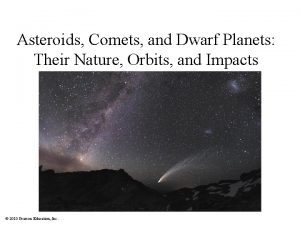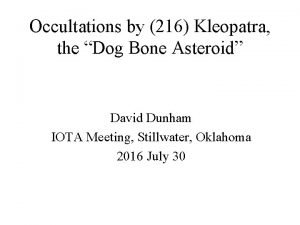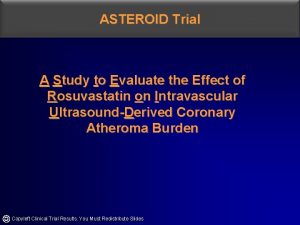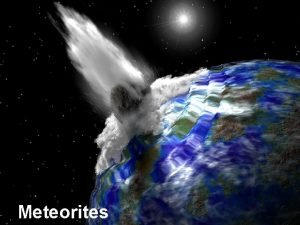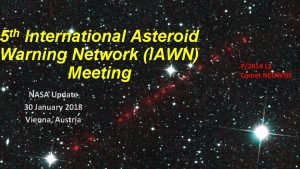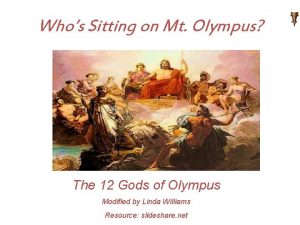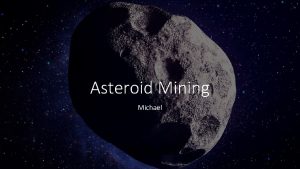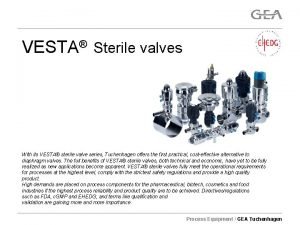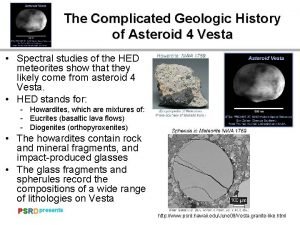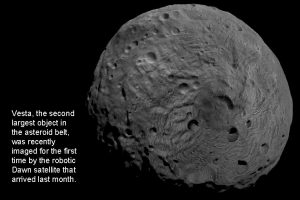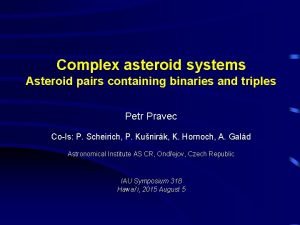Title Vesta Is asteroid 4 Vesta with watery














- Slides: 14

Title - Vesta Is asteroid 4 Vesta, with watery 1 Ceres and the Galilean moons, a record of Ringwood-mode iron core construction now predicated for Earth? Miles F Osmaston Woking, UK miles@osmaston. demon. co. uk http: //osmaston. org. uk EPSC 2014 Cascais, Portugal. Session SB 4, 10 Sept 2014 Abstr #EPSC 2014 -535 Copyright © 2014 Miles F Osmaston – 14 slides 1 of 14

Setting the scene DAWN observations have confirmed that Vesta, with its mean diameter of 530 km and a mass ~1/20, 000 of Earth, was too small to experience appreciable magmatic resurfacing after accretion had ended. With its 220 km diameter iron core and as the source of the HED meteorite family, Vesta preserves valuable clues as to how the Earth and the other terrestrials were built. Core formation in the terrestrial planets has long been attributed to the percolation of molten Fe. Ni accreted from the (hot) solar nebula, either inward from the surface or from a magma ocean at depth. But we now know [Halliday 2013, Craddocketal 2013] that the 56 Fe/54 Fe ratio in Earth peridotites is still the chondritic one, ruling out that Fe ever percolated through it. 2 of 14

Ringwood-mode (RM) core formation So we must now revert to A. E. (Ted) Ringwood’s model for core formation [ANU papers and books, 1960 -1979]. This uses the nebular H to reduce the hot Fe. O in lavas erupted at the protoplanet’s volcanoes, generating lots of reaction water and subducting the iron in big lumps. So the action is limited to while the nebula is present. This fits nicely with tackling the problem of equipping the solar planets with their huge (>105 -fold higher) mean specific orbital a. m. , w. r. t. the a. m. of solar rotation (noted by Jeans 1919 and by a succession of notable others since). [The Nice and other SS models don’t tackle it either!] At EPSC-2013 I showed that this can be done, but only if the nebula is the mechanical agent. So construction has to be completed while it’s present (5 Ma or less? ). 3 of 14

Nebula-present core formation – Ringwood model 4 of 14

Some implications of the model To provide Fe as Fe. O for planetary construction, thermodynamics specifies that the protoplanetary disc must be very cool (<600 K). That is provided by our EPSC 2013 scenario. In this the proto-Sun travels through a second dust cloud (typical temperature only 10 K) gathering dusty material to form the disc, and contaminating the above-tachocline part of the Sun, an unmixed star. [and picking up short-life 26 Al, 41 Ca from a source near the far end. ] The dust-opacity of that cool disc isolated the formation of protoplanetary bodies from the influence of solar distance. The RM volcanism for core formation needs only localized melting in the body - far less than for its wholesale ‘differentiation’ – so it can form cores in much smaller bodies. In these, the heating will be maintained by accretion and by the Fe-loaded ‘conveyor belt’, releasing gravitational energy. So it will cease soon after nebular departure, with very little volcanic resurfacing to hide what had happened. 5 of 14

What would a Ringwood-mode (RM) volcano look like? I propose the following top-to-bottom profile of its axial character, bearing in mind that volcanic fractionation processes habitually differ from one volcano to the next and even between successive eruptions. So detailed uniformity is not to be expected among the meteorites that sample them. They are sampling a process, NOT a single body of material. Eucrite Diogenite Mesosiderite Pallasite Irons The overall picture is that Fe. Ni melt is produced by nebular reaction during eucrite melting and it trickles down to accumulate as the irons at the bottom. Howardite is clearly a regolith material derived from eucrite and diogenite, so merely confirms the wider exposure of these. 6 of 14

The RM volcano profile in more detail Eucrite Diogenite Mesosiderite Pallasite Irons Eucrite volcanic melt compositions mark partial melting of the chondrite material that had built Vesta. Fe. Ni metal is present in some, with apatite indicating water, recording action of the RM nebular process. Eucrites that do not may postdate nebular departure. Diogenite has more metal, presumably drained down from above, with a marked variability of its alloy composition. Mesosiderite. Its brecciated character, incorporating E and D components from above, suggests magma chamber convective overturn. It has even more metal than D, up to 4 cm size, that had resisted brecciation. Pallasite. Essentially a mass of initially-angular high. Mg typical cumulate olivines, surrounded by Fe. Ni metal that has trickled down from above. Irons. The final pool of Fe. Ni metal below the silicate. 7 of 14

What does pallasite look like 2 examples from the Imilac shower Rounding of the olivines and their kamacite(? ) borders may be due to Earth-entry or other heating. (arizonaskiesmeteorites. com) (Smithsonian. Contr. ESci-0031) (Hutchison 2004) A rare example (Esquel) of the probable initial condition, with metal filling the narrow cracks between olivines. 8 of 14

What about the resulting reaction water? The reaction mass-equation is Fe. O(72) + 2 H(2) = Fe(56) + H 2 O(18) So, for every kg of Fe metal produced, there will also be 18/56 = 0. 32 kg of water For its 220 km core diameter with a 10 vol% of light element, the water generated would cover Vesta’s 530 km diameter outer surface to a depth of 14. 5 km. [Correction: ‘ 30 km’ in my abstract] For precision this would need adjustments, here ignored, for: (1) Additional Fe (Fe. Ni actually) still residing, globally, in the bottoms of the many volcanoes that never made it to a ‘subduction’ zone, and are the sources of our iron meteorites; (2) All the reaction water sequestered, during metal subduction, into the mineral structure of Vesta’s mantle. (3) So we’ll take the mean water thickness to have been around 14. 5 km by the time the nebula departed. Before this moment, nebular opacity would have ensured that all this was frozen, shielding the crust from impacts, and would have prevented sublimation of the ice. 9 of 14

What next? - 1 On nebular departure and Vesta’s exposure to solar radiation, the top of the ice would start to sublime, and the lower 10 km(? ) would melt, with vigorous regolith-scouring water-current flows below the ice, Coriolis-deflected at high latitude by Vesta’s fast (5. 3 hr) prograde rotation. Circum-south polar spiral scouring outboard of Rheasilvia impact basin (DAWN video – NASA) These curved features suggest that the diogenitic regolith in the floor of the Rheasilvia basin was subject to scouring water flows after the impact, so the impact may have been quite early. The quasiequatorial grooving is Vesta. Coriolisat. Rheasilvia also seen. (Ottoetal-2013 EPSC) 10 of 14

What next? - 2 Eventually, all the ice and water would vanish by sublimation and evaporation, exposing the crustal regolith surface to general inter-asteroidal bombardment, as we see it now. (DAWN video – NASA) This image confirms that this cratering postdated the grooving of the regolith by deep-water currents. Development of such deep regolith suggests glacial action for a major interval while nebular opacity was keeping frozen all the water being generated at Ringwood-mode volcanoes. 11 of 14

Widmanstätten fabric in ‘irons’ Composed of taenite and kamacite, this example is from the Gibeon shower, Namibia. (courtesy Wikipedia). Formation of this mmscale structure is thought to require very slow cooling, although similar structures at the micrometre scale are formed very rapidly in the lab. Extreme extrapolation has led to the view that this slowness can only be found in the iron cores of asteroids, meaning that ‘iron’ meteorites must have come from broken-open cores – a very difficult achievement. S, P, Ca & C, (all potentially included by the Ringwood model) may reduce the slowness. Our analysis prefers that the slowness demanded may be no slower than prevailed at the bottom of a Ringwood-mode volcano, whence the irons and stony-irons are readily ejected as meteorites. The lack of mantle-like meteorites (Burbine etal 1996) is then also explained. (Extreme extrapolation of any physical process always carries the risk that a factor, formerly negligible, becomes the controlling one. ) 12 of 14

Was Earth built in the same way as Vesta? Some core-construction links Ringwood-mode core formation would cease in all terrestrial-type bodies at nebular departure, leaving their mantles replete with reaction water - but still containing some Fe. O. For Earth, we see the results in the mantle’s 7. 5 wt%Fe. O. And the water both in the 4374 Ma detrital zircons from waterrequiring granitoids [Valley et al 2014]; and in its stillcontinuing abundance in water-rich ringwoodite in the TZ at the bottom of the upper mantle [Pearson et al 2014]. Vesta has hydroxyl in its regolith, and apatite in eucrites. In smaller bodies (less gravity) the Ringwood process would run slower, leaving more Fe. O in their mantles to put into their volcanic products. Eucrites (Vesta) have ~18 wt% Fe. O, nearly double that of MORB on Earth’s East Pacific Rise [Cottrell & Kelly 2011]. 13 of 14

Main conclusions • Ringwood-mode core formation needs nebular presence for the reaction, so it would cease in all terrestrial-type bodies at nebular departure, leaving their mantles replete with reaction water and with a high f. O 2 - but still containing some Fe. O. • Bar the Moon, all the other terrestrials with iron cores, including the Galilean moons of Jupiter, were likely made similarly, with Europa offering a near-perfect water-iron ratio for the reaction. • The Moon’s highly depleted HSEs and dryness show that it alone experienced core formation by melt percolation. This resulted from its high assembly-temperature; and its dryness from its post-nebular time of formation. • We predict that 1 Ceres has an iron core, whose formation would explain the water/ice volume present, although extraneous acquisition of it isn’t impossible. Thank you 14 of 14
 Watery humour
Watery humour Asteroid impact simulation
Asteroid impact simulation Eureka asteroid
Eureka asteroid Asteroid belt origin
Asteroid belt origin Dog bone asteroid
Dog bone asteroid Serpentis forsaken hideaway
Serpentis forsaken hideaway Asteroid trial
Asteroid trial Meteorite identification pictures
Meteorite identification pictures Scintillate scintillate asteroid minific
Scintillate scintillate asteroid minific Asteroid belt
Asteroid belt 1981et3
1981et3 Where can we mostly asteroid found
Where can we mostly asteroid found Hestia
Hestia Whos roman name is juno
Whos roman name is juno Solcata ho fronte figure retoriche
Solcata ho fronte figure retoriche
